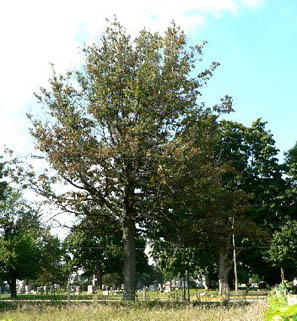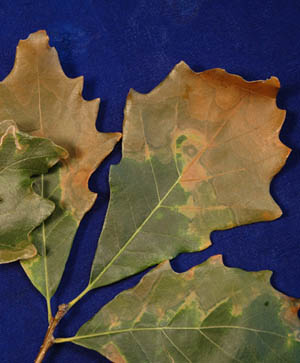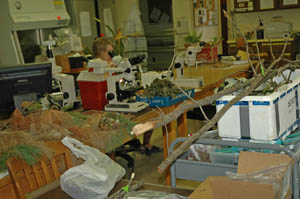Does Your Tree Have BLS? | |
|---|---|
| August 22, 2008 | |
|
Bacterial leaf scorch (BLS) is a deadly disease for many trees. It starts out with leaf scorch but progresses 8 years or longer to kill or contribute to the death of large trees. How do you know whether your tree may be infected? Refer to issues no. 15 and 19 in the 2007 edition of this newsletter. Large trees (especially oaks) that have healthy leaves each spring, develop scorched foliage by midsummer, and seem to be getting worse each year are most suspect. Infected trees show scorching weeks before surrounding trees begin to dry down in the fall. This image shows symptoms on an entire oak tree.  The second image shows foliar symptoms on an oak infected with BLS.  This tree has since died (an 8-year process) and has been removed. Some possible tree hosts include pin, red, scarlet, bur, white, willow, and shingle oaks; silver, sugar, and red maples; sweetgum; sycamore; planetree; hackberry; American elm; and red mulberry. For more information on symptoms, as well as plenty of images, go to this Web site by the National Arboretum: http://www.usna.usda.gov/Research/BacterialLeafScorch.html. Not every scorched tree has BLS. There is plenty of environmental scorch in our landscapes. A report discussing noninfectious leaf scorch can be found at this Web site, http://www.ag.uiuc.edu/~vista/abstracts/a620.html. The Plant Clinic at the University of Illinois will be testing trees for the presence of Xyllella, a bacterial pathogen that causes bacterial leaf scorch (BLS) of trees. Common lab procedures to detect bacteria do not work with this bacterium. We need to assay with ELISA (enzyme-linked immunosorbant assay) to be certain this bacterium is present. The clinic runs this particular ELISA only in the fall. If you have a suspect tree, send a sample in for testing. We will run assays the last week in August and the first week of September at the normal clinic fee of $12.50. We can accept only Illinois samples. How do I prepare a sample for testing? We are going to grind the sample and extract plant sap to use in the ELISA. For this reason, we need live plant material showing symptoms. Send three branch tips, each about 3 inches long, with all the leaves attached. Flatten and place these in a zip-lock plastic bag, labeled with the tree species and the words “for BLS testing.” Enclose a completed specimen data form (http://plantclinic.cropsci.uiuc.edu/hortdf.pdf) and your check payable to the University of Illinois for $12.50. Send by overnight express or one-day service to Plant Clinic, 1401 W. St. Mary’s Rd, Urbana, IL 61802. Call (217)333-0519 if you have questions. (Nancy Pataky) Plant Clinic Thriving The University of Illinois Plant Clinic is a seasonal laboratory. Some have called to find out whether we are still open. Yes, we are open from May 1 through mid-September every year. Our official closing date for 2008 is September 15. Anything submitted by that date will be completed, no matter how long it takes us to culture or otherwise process the samples. Most of the Midwest plant labs started out slowly because of cool, wet weather. Now we are all working diligently to keep up with the constant flow of samples. For details on submitting samples, consult our Web pages at http://plantclinic.cropsci.uiuc.edu/. The image shows a busy day at he Plant Clinic.  | |
| Author: | Nancy Pataky |
